Format Dial Gauge Dialog
The Format Dial Gauge dialog helps you to format a dial gauge. It appears when you right-click any pointer in a dial of a dial gauge and select Format Dial Gauge from the shortcut menu, or double-click any pointer in a dial of a dial gauge.
The dialog contains the following tabs: Circular Graph, Axis, Pointer, Target, Frame, Range Color, Hint and Behaviors (the Behaviors tab is available to charts in library components only).
Sample
Displays a preview sample of your selection.
OK
Applies the changes and closes the dialog.
Cancel
Does not retain any changes and closes the dialog.
Apply
Applies all changes and leaves the dialog open.
Help
Displays the help document about this feature.
Circular Graph
Specifies properties for the dials in the dial gauge.
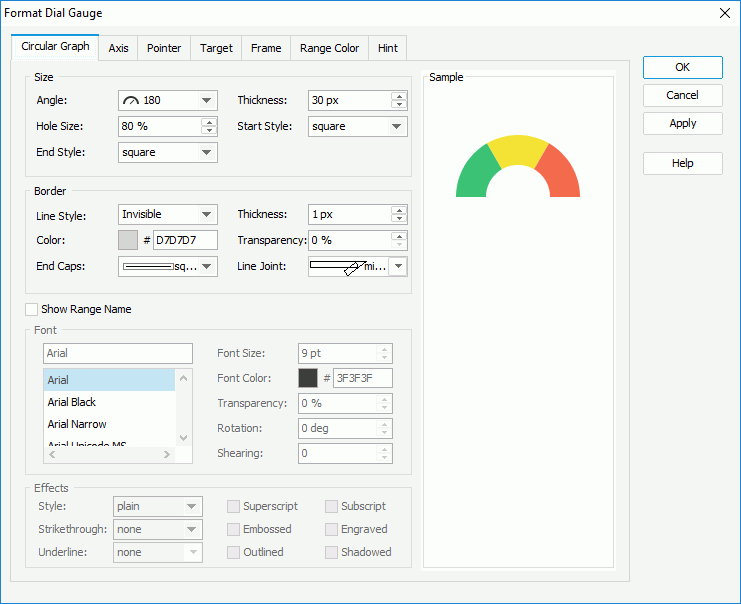
Size
Specifies the size of the dials.
- Angle
Specifies the degree for angles of the dials. Select the angle of the gauge from the drop-down list or select Customized to open the Customize Gauge Angle dialog to specify the start angle and stop angle. - Thickness
Specifies the thickness of the dials, in pixels. - Hole Size
Specifies the relative size of a dial in a percentage of total dial size. - Start Style
Specifies the style of the start graph of the dials. - End Style
Specifies the style of the end graph of the dials.
Border
Specifies properties for borders of the dials.
- Line Style
Specifies the line style to apply to the border. - Thickness
Specifies the thickness of the border, in pixels. - Color
Specifies the color of the border. - Transparency
Specifies the transparency for color of the border. - End Caps
Specifies the ending style of the border line.- butt
Ends unclosed sub paths and dash segments with no added decoration. - round
Ends unclosed sub paths and dash segments with a round decoration that has a radius equal to half of the width of the pen. - square
Ends unclosed sub paths and dash segments with a square projection that extends beyond the end of the segment to a distance equal to half of the line width.
- butt
- Line Joint
Specifies the line joint style for the border line.- miter
Joins path segments by extending their outside edges until they meet. - round
Joins path segments by rounding off the corner at a radius of half the line width. - bevel
Joins path segments by connecting the outer corners of their wide outlines with a straight segment.
- miter
Show Range Name
Specifies whether to show the names of the ranges defined in the Range Color tab. When it is checked, the following options are enabled.
- Font
Specifies the font format of text in the range names.- Font list
Lists all the available font faces that can be selected to apply to the text. - Font Size
Specifies the font size of the text. - Font Color
Specifies the font color of the text. - Transparency
Specifies the color transparency of the text. - Rotation
Specifies the rotation angle of the text around its center, in degrees. The default value is 0. - Shearing
Specifies the gradient of the text.
- Font list
- Effects
Specifies the special effects of text in the range names.- Style
Specifies the font style of the text. It can be one of the following: plain, bold, italic, and bold italic. - Strikethrough
Specifies the style of the horizontal line with which the text is struck through. It can be one of the following: none, thin line, bold line, and double lines. - Underline
Specifies the style of the horizontal line under the text. It can be one of the following: none, single, single lower, bold line, bold lower, double lines, bold double, patterned line, and bold patterned. When patterned line or bold patterned is selected, a line or bold line in the pattern of the text will be drawn.Note: Web Report Studio and JDashboard do not support underlining chart text so this property will be ignored when the chart runs in Web Report Studio or is used in a dashboard.
- Superscript
Raises the text above the baseline and changes the text to a smaller font size, if a smaller size is available. - Embossed
Makes the text appear to be raised off the page in relief. - Outlined
Displays the inner and outer borders of each character. - Subscript
Lowers the text below the baseline and changes the text to a smaller font size, if a smaller size is available. - Engraved
Makes the text appear to be imprinted or pressed into the page. - Shadowed
Adds a shadow beneath and to the right of the text.
- Style
Axis
The tab consists of four sub tabs: Axis, Tick Mark, Label and Format.
Axis
Specifies properties of the axis in the dial gauge.
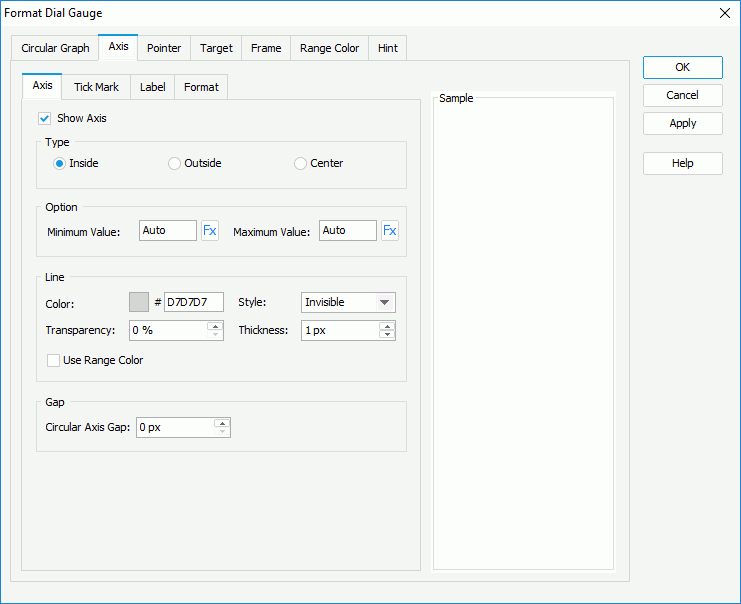
Show Axis
Specifies whether to show the axis in the dial gauge.
Type
Specifies the position relationship of the axis and the dials.
- Inside
If selected, the axis will be inside the dials. - Outside
If selected, the axis will be outside the dials. - Center
If selected, the axis will be in the center of the dials.
Specifies the values to display on the axis.
- Minimum
Specifies the minimum value of the axis. You can also use a formula to control the property. - Maximum
Specifies the maximum value of the axis. You can also use a formula to control the property.
Specifies the properties of the axis line.
- Color
Specifies the color of the line. - Transparency
Specifies the transparency for color of the line. - Style
Specifies the style of the line. - Thickness
Specifies the thickness of the line. - Use Range Color
Specifies whether to use the color you define for the ranges as the line color. If checked, the Color and Transparency options will be disabled.
Gap
Specifies the gap between the axis and the dials if the axis is displayed inside or outside of the dials.
Tick Mark
Specifies properties of the tick marks on the axis.
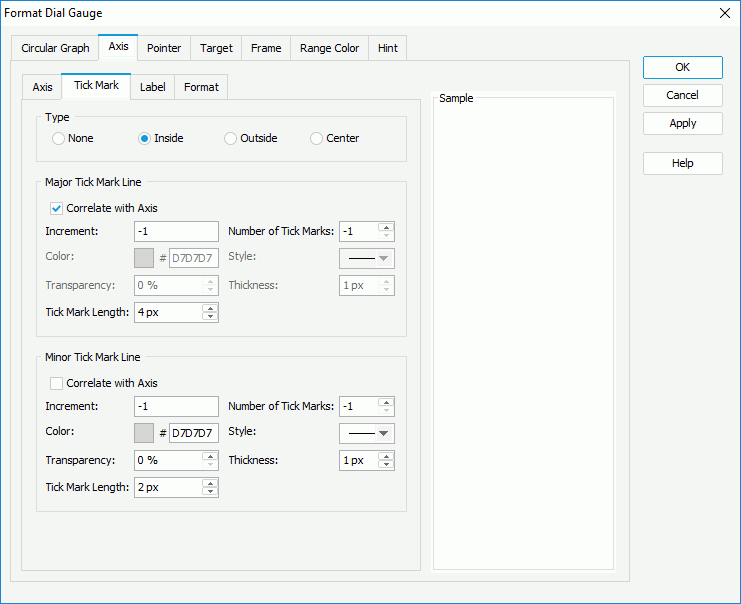
Type
Specifies the type of the tick marks on the axis.
- None
Specifies not to display the tick marks on the axis. It's meaningless to specify all the other tick mark related properties if this type is selected. - Inside
Specifies to display the tick marks inside the axis. - Outside
Specifies to display the tick marks outside the axis. - Center
Specifies to display the tick marks in the center of the axis.
Major Tick Mark Line
Specifies properties of the major tick mark line.
- Correlate with Axis
If checked, the line properties of the major tick marks will correlate with that of the axis automatically.- Color
Specifies the color of the major tick mark line. Disabled when Use Range Color in the Axis sub tab is checked. - Style
Specifies the style of the major tick mark line. - Transparency
Specifies the color transparency of the major tick mark line. Disabled when Use Range Color in the Axis sub tab is checked. - Thickness
Specifies the thickness of the major tick mark line.
- Color
- Increment
Specifies the distance between two adjacent major tick marks on the axis. - Number of Tick Marks
Specifies how many major tick marks to be displayed on the axis. - Tick Mark Length
Specifies the length of the major tick mark line.
Minor Tick Mark Line
Specifies properties of the minor tick mark line.
- Correlate with Axis
If checked, the line properties of the minor tick marks will correlate with that of the axis automatically.- Color
Specifies the color of the line. Disabled when Use Range Color in the Axis sub tab is checked. - Style
Specifies the style of the line. - Transparency
Specifies the color transparency of the line. Disabled when Use Range Color in the Axis sub tab is checked. - Thickness
Specifies the thickness of the line.
- Color
- Increment
Specifies the distance between two adjacent minor tick marks on the axis. - Number of Tick Marks
Specifies how many minor tick marks to be displayed on the axis. - Tick Mark Length
Specifies the length of the minor tick mark line.
Label
Specifies properties of the major tick mark labels.

Type
Specifies the type of the labels.
- None
If selected, the labels will not be shown. - Normal
If selected, the labels will be shown as you specify.- Label Every N Major Tick Marks
Specifies the frequency at which the major tick marks will be labeled. - Number of Major Labels
Specifies how many major tick mark labels to be displayed on the axis.- Auto
If checked, all major tick mark labels will be shown. - Fixed
If checked, you can specify the number of the major tick mark labels to be displayed on the axis.
- Auto
- Label Every N Major Tick Marks
- Range Value
If selected, the labels will show the range values you define. - Min and Max Values
If selected, the labels will show the minimum value and maximum value defined in the Axis sub tab.
Gap
Specifies the gap properties for the data labels.
- Label Axis Gap
Specifies the distance between the data label and the axis, in pixels. - Best Effect
Specifies whether to adjust the data labels automatically to make them placed best. If checked, some labels will be hidden when they are overlapped.
Font
Specifies the font format of text in the data labels.
- Font list
Lists all the available font faces that can be selected to apply to the text. - Font Size
Specifies the font size of the text. - Font Color
Specifies the font color of the text. Disabled when Use Range Color in the Axis sub tab is checked. - Transparency
Specifies the transparency for color of the text. Disabled when Use Range Color in the Axis sub tab is checked. - Rotation
Specifies the rotation angle of the text around its center, in degrees. The default value is 0. - Shearing
Specifies the gradient of the text.
Effects
Specifies the special effects of text in the tick mark labels.
- Style
Specifies the font style of the text. It can be one of the following: plain, bold, italic, and bold italic. - Strikethrough
Specifies the style of the horizontal line with which the text is struck through. It can be one of the following: none, thin line, bold line, and double lines. - Underline
Specifies the style of the horizontal line under the text. It can be one of the following: none, single, single lower, bold line, bold lower, double lines, bold double, patterned line, and bold patterned. - Superscript
Raises the text above the baseline and changes the text to a smaller font size, if a smaller size is available. - Embossed
Makes the text appear to be raised off the page in relief. - Outlined
Displays the inner and outer borders of each character. - Subscript
Lowers the text below the baseline and changes the text to a smaller font size, if a smaller size is available. - Engraved
Makes the text appear to be imprinted or pressed into the page. - Shadowed
Adds a shadow beneath and to the right of the text.
Format
Specifies the data format of the major tick mark labels.
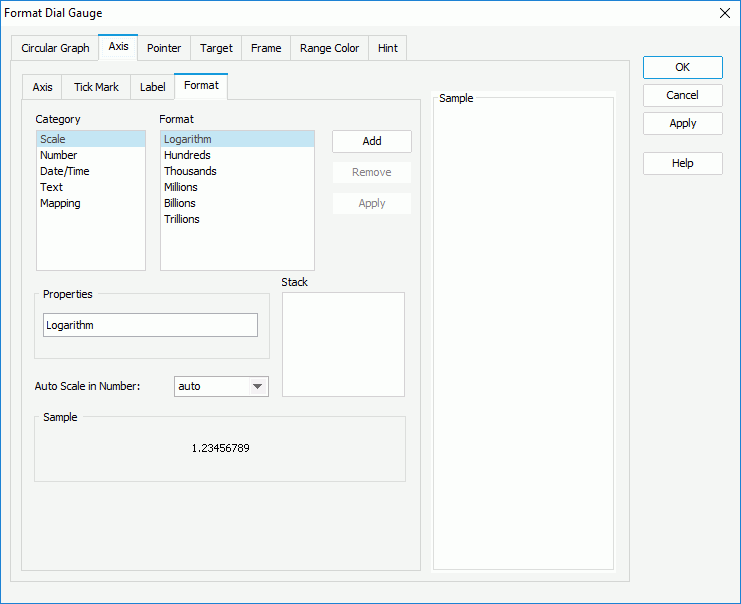
Category
Lists the category types. Select one to customize its format.
Format
Displays all the formats of the selected category. Select the required one and select Add to add it as the format of the specified category. You can add only one format for each category.
Properties
Displays the properties of the format you select. If the formats listed in the Format box cannot meet your requirement, define the format in the text field and then select Add to add it as the format of the specified category.
Specifies whether to automatically scale the major tick mark labels that are of the Number data type when the label values fall into the two ranges:
- When 1000 <= value < 10^15, the following quantity unit symbols of the International System of Units are used to scale the values: K (10^3), M (10^6), G (10^9), and T (10^12).
- When 0 < value < 0.001 or value >= 10^15, scientific notation is used to scale the values.
By default it is set to auto which means that the setting follows that of the chart. When it is true, the specified format applies to the integer part of the values after scaled, but if the specified format conflicts with Auto Scale in Number, for example the values are displayed in percentage, then the Auto Scale in Number setting is ignored.
Stack
Lists all the formats you select from different categories.
Add
Adds a format to the Stack list box.
Remove
Removes a format from the Stack list box.
Apply
Applies the specified format in the Stack list box to the major tick mark labels.
Pointer
Specifies properties for the pointers in the dial gauge.
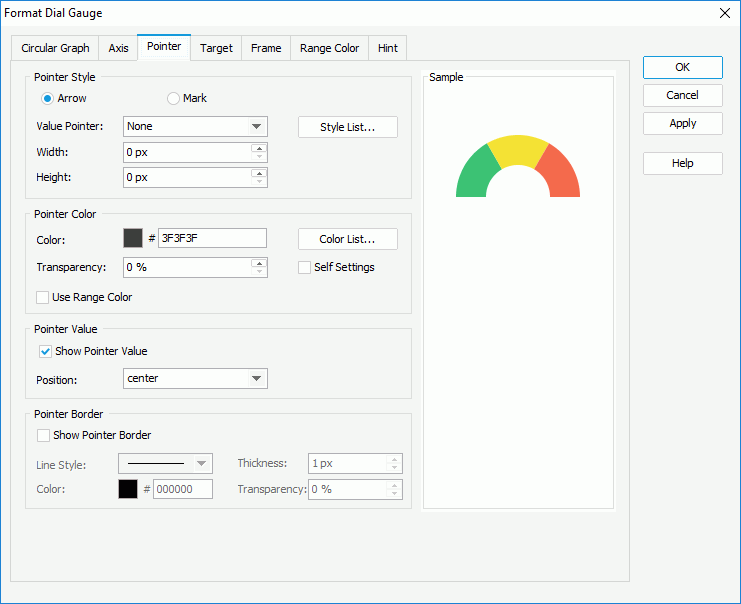
Pointer Style
Specifies the style of the pointers.
- Arrow
Specifies to use arrow as the pointer style.- Value Pointer
Specifies the style of the value pointer. Select a style from the drop-down list or select Customized and specify another image as the value pointer. - Width
Specifies the width of the arrow. - Height
Specifies the height of the arrow.
- Value Pointer
- Mark
Specifies to use mark as the pointer style.- Value Pointer
Specifies the style of the value pointer. Select a style from the drop-down list or select Customized and specify another image as the value pointer. - Width
Specifies the width of the marks. - Height
Specifies the height of the marks. - Position
Specifies the position relationship of the marks and the dial. - Gap
Specifies the distance between the pointer and the dial, in pixels.
- Value Pointer
- Style List
Opens the Style List dialog to specify the style for pointers in the same data series respectively.
Pointer Color
Specifies color properties of the pointers.
- Color
Specifies the color of the pointers. - Color List
Opens the Color List dialog to modify the color pattern for pointers in the same data series respectively. - Transparency
Specifies the transparency for color of the pointers. Self Settings
Specifies whether to edit the color pattern for the pointers themselves. When unchecked, the color settings defined here will be synchronized to the Pattern List property on the chart object in the Report Inspector, which can also be applied by data markers of other subtypes if the chart is a combo chart.- Use Range Color
Specifies whether to use the color defined for the ranges as the pointer color. If checked, the three properties above will be disabled.
Pointer Value
Specifies the pointer value properties.
- Show Pointer Value
Specifies whether to show the pointer values.- Position
Specifies the position relationship between the values and the pointers. Select the position from the drop-down list or select customized to customize the position by dragging any pointer value in the design area.
- Position
Pointer Border
Specifies properties for the border of the pointers.
- Show Pointer Border
Specifies whether to show the border of the pointers. When it is checked, the following border properties are enabled.- Line Style
Specifies the line style to apply to the border. - Thickness
Specifies the weight of the border, in pixels. - Color
Specifies the color of the border. - Transparency
Specifies the transparency for color of the border.
- Line Style
Target
Specifies properties of the target in the dial gauge.

Use Target Value
Specifies whether to use target value for the dial gauge.
- Target Value
Specifies the target value. You can also use a formula to control the value.
Pointer Style
Specifies the pointer style for the target value.
- Target Pointer
Specifies the style of the target pointer. Select a style from the drop-down list or select Customized and specify another image as the target pointer. - Width
Specifies the width of the target pointer. - Height
Specifies the height of the target pointer. - Position
Specifies the position of the target pointer relative to the dial. - Gap
Specifies the distance between the target pointer and the dial.
Pointer Color
Specifies color properties of the target pointer.
- Color
Specifies the color of the target pointer. - Transparency
Specifies the transparency for color of the target pointer.
Target Value
Specifies properties of the target value.
- Show Pointer Value
Specifies whether to show the target value on the dial gauge.- Position
Specifies the position of the target value relative to the dial. Select the position from the drop-down list or select customized to customize the position by dragging the target value in the design area.
- Position
Frame
Specifies properties for the frame of the dial gauge.
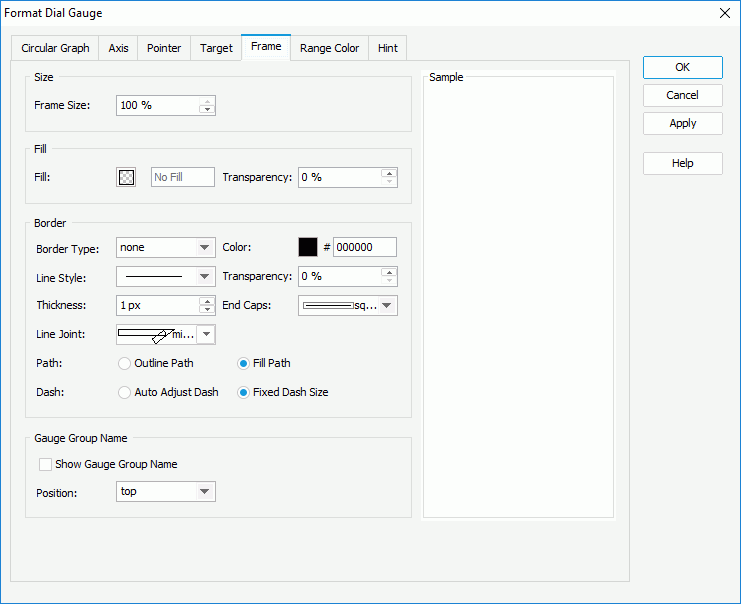
Size
Specifies the size properties of the frame.
- Frame Size
Specifies the size of the frame.
Fill
Specifies the color and transparency of the frame.
- Fill
Specifies the color to fill the frame. - Transparency
Specifies the transparency of the color to fill the frame.
Border
Specifies the properties for border of the frame.
- Border Type
Specifies the type of the border. - Color
Specifies the color of the border. To edit the color, select the color indicator and select a color from the color palette or input the hexadecimal value (for example, 0xff0000) of a color directly in the text box. - Line Style
Specifies the line style to apply to the border. - Transparency
Specifies the transparency for color of the border. - Thickness
Specifies the thickness of the border, in pixels. End Caps
Specifies the ending style of the border line.- butt
Ends unclosed sub paths and dash segments with no added decoration. - round
Ends unclosed sub paths and dash segments with a round decoration that has a radius equal to half of the width of the pen. - square
Ends unclosed sub paths and dash segments with a square projection that extends beyond the end of the segment to a distance equal to half of the line width. - Line Joint
Specifies the line joint style for the border line.- miter
Joins path segments by extending their outside edges until they meet. - round
Joins path segments by rounding off the corner at a radius of half the line width. - bevel
Joins path segments by connecting the outer corners of their wide outlines with a straight segment. - joint round
Joins path segments by rounding off the corner at the specified radius.
- miter
Path
Specifies the fill pattern of the border line.- Outline Path
Specifies the fill pattern of the border line to be outline path. - Fill Path
Specifies the fill pattern of the border line to be whole path.
- Outline Path
- Dash
Specifies the dash size of border line.- Auto Adjust Dash
If selected, the dash size will be adjusted automatically. - Fixed Dash Size
If selected, the dash size will be fixed size.
- Auto Adjust Dash
Gauge Group Name
Specifies properties for the gauge group name.
- Show Gauge Group Name
Specifies whether to show names for the arcs in the dial gauge which are values of the field on its category axis. If the dial gauge contains no category field, the group name shows Report by default.- Position
Specifies the position of the names relative to the dial.
- Position
Range Color
Specifies different colors to fill the dials in different ranges.
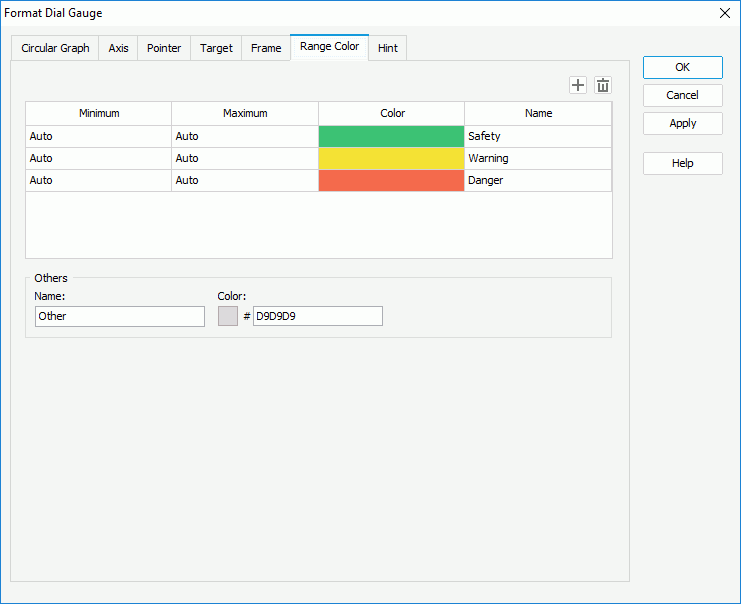

Adds a new color range.

Removes the selected color range.
Minimum
Specifies the minimum value of the range.
Maximum
Specifies the maximum value of the range.
Color
Specifies the color schema of the range. Select in the color cell to customize the color on the color palette.
Name
Displays the name of the range.
Others
Specifies the properties for values that do not fall into any of the ranges you define.
- Name
Specifies the name for the values. - Color
Specifies the color for the values. To edit the color, select the color indicator and select a color from the color palette or input the hexadecimal value (for example, 0xff0000) of a color directly in the text box.
Hint
Specifies properties for the hint of the dial gauge.
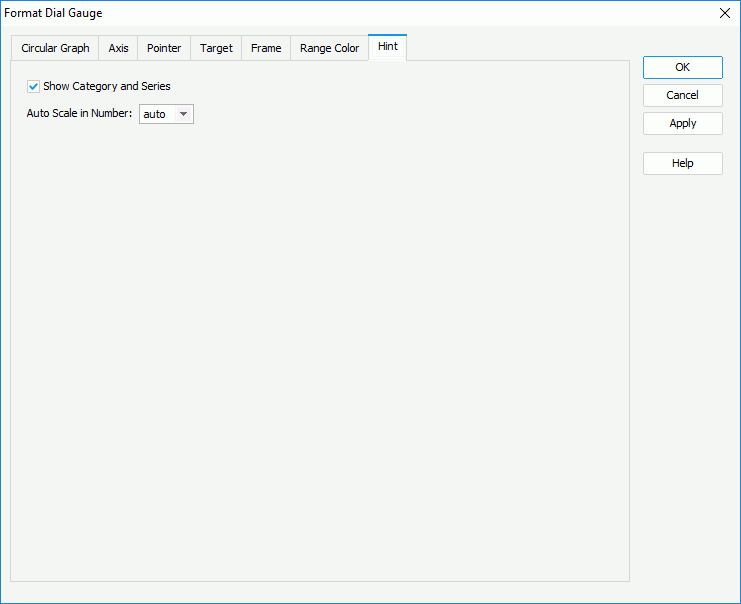
Show Category and Series
Specifies whether to include the category and series values in the hint.
Auto Scale in Number
Specifies whether to automatically scale the values displayed in the hint that are of the Number data type when the values fall into the two ranges:
- When 1000 <= value < 10^15, the following quantity unit symbols of the International System of Units are used to scale the values: K (10^3), M (10^6), G (10^9), and T (10^12).
- When 0 < value < 0.001 or value >= 10^15, scientific notation is used to scale the values.
The option "auto" means that the property setting follows that of the chart.
Behaviors
Specifies web behaviors to the dial gauge. This tab is only available to charts in library components.


Adds a new web behavior line.

Removes the selected web behavior.

Moves the selected web behavior up a step.

Moves the selected web behavior down a step.
Events
Specifies the trigger event.
Actions
Specifies the action you want the event to trigger.

Opens the Web Action List dialog to bind a web action to the event.
 Previous Topic
Previous Topic